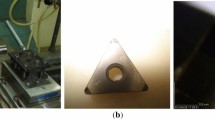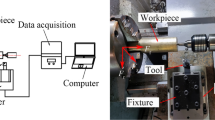Abstract
Friction stir spot welding (FSSW) experiments were carried out on polycarbonate sheets to assess the influence of the tool geometry on the joining loads and material flow. An instrumented drilling machine was used to measure the plunging load and the torque developing during the process. Different tool geometries were tested involving the variation of the tool pin shape (cylindrical or tapered), diameter of the tool pin, and diameter of the tool shoulder. The analysis of material flow enabled understanding the behavior of the load and torque trends measured during the process, such as the presence of load peaks during the plunging phase and reduced values of the axial pressure during the process. It was discovered that the average axial pressure was higher during pin plunging (such value was mainly determined by the pin diameter) while it dramatically decreased (almost to 1.2 MPa) during shoulder plunging owing to the higher heating resulting from higher tangential speed. The pin taper angle had negligible influence on the plunging load and torque. The tool shoulder influenced the plunging load and torque while it produced a negligible variation in the average axial pressure. On the other hand, the pin diameter influenced both the process loads and the axial pressure.
Similar content being viewed by others
References
Lambiase F (2015) Mechanical behaviour of polymer-metal hybrid joints produced by clinching using different tools. Mater Des 87:606–18
Simões F, Rodrigues DM (2014) Material flow and thermo-mechanical conditions during friction stir welding of polymers: literature review, experimental results and empirical analysis. Mater Des 59:344–51
Bilici MK (2012) Effect of tool geometry on friction stir spot welding of polypropylene sheets. Express Polym Lett 6:805–13
Bilici MK, Yükler Aİ (2012) Influence of tool geometry and process parameters on macrostructure and static strength in friction stir spot welded polyethylene sheets. Mater Des 33:145–52
Hoseinlaghab S, Mirjavadi SS, Sadeghian N, Jalili I, Azarbarmas M, Besharati Givi MK (2015) Influences of welding parameters on the quality and creep properties of friction stir welded polyethylene plates. Mater Des 67:369–78
Panneerselvam K, Lenin K (2014) Joining of nylon 6 plate by friction stir welding process using threaded pin profile. Mater Des 53:302–7
Sadeghian N, Besharati Givi MK (2015) Experimental optimization of the mechanical properties of friction stir welded acrylonitrile butadiene styrene sheets. Mater Des 67:145–53
Bilici MK, Yükler Aİ, Kurtulmuş M (2011) The optimization of welding parameters for friction stir spot welding of high density polyethylene sheets. Mater Des 32:4074–9
Bilici MK, Yukler AI (2012) Effects of welding parameters on friction stir spot welding of high density polyethylene sheets. Mater Des 33:545–50
Lambiase F, Paoletti A, Di Ilio A (2015) Mechanical behaviour of friction stir spot welds of polycarbonate sheets. Int J Adv Manuf Technol 80:301–14
Mendes N, Loureiro A, Martins C, Neto P, Pires JN (2014) Effect of friction stir welding parameters on morphology and strength of acrylonitrile butadiene styrene plate welds. Mater Des 58:457–64
Mendes N, Loureiro A, Martins C, Neto P, Pires JN (2014) Morphology and strength of acrylonitrile butadiene styrene welds performed by robotic friction stir welding. Mater Des 64:81–90
Mendes N, Neto P, Simão MA, Loureiro A, Pires JN (2014) A novel friction stir welding robotic platform: welding polymeric materials. Int J Adv Manuf Technol
Bozkurt Y (2012) The optimization of friction stir welding process parameters to achieve maximum tensile strength in polyethylene sheets. Mater Des 35:440–5
Vijendra B, Sharma A (2015) Induction heated tool assisted friction-stir welding (i-FSW): a novel hybrid process for joining of thermoplastics. J Manuf Process 20:234–44
Bagheri A, Azdast T, Doniavi A (2013) An experimental study on mechanical properties of friction stir welded ABS sheets. Mater Des 43:402–9
Mostafapour A, Azarsa E (2012) A study on the role of processing parameters in joining polyethylene sheets via heat assisted friction stir welding: investigating microstructure, tensile and flexural properties. Int J Phys Sci 7
Azarsa E, Mostafapour Asl A, Tavakolkhah V (2012) Effect of process parameters and tool coating on mechanical properties and microstructure of heat assisted friction stir welded polyethylene sheets. Adv Mater Res 445:765–70
Pirizadeh M, Azdast T, Rash Ahmadi S, Mamaghani Shishavan S, Bagheri A (2014) Friction stir welding of thermoplastics using a newly designed tool. Mater Des 54:342–7
Oliveira PHF, Amancio-Filho ST, dos Santos JF, Hage E (2010) Preliminary study on the feasibility of friction spot welding in PMMA. Mater Lett 64:2098–101
Goushegir SM, dos Santos JF, Amancio-Filho ST (2015) Influence of process parameters on mechanical performance and bonding area of AA2024/carbon-fiber-reinforced poly(phenylene sulfide) friction spot single lap joints. Mater Des 83:431–42
Esteves JV, Goushegir SM, dos Santos JF, Canto LB, Hage E, Amancio-Filho ST (2015) Friction spot joining of aluminum AA6181-T4 and carbon fiber-reinforced poly(phenylene sulfide): effects of process parameters on the microstructure and mechanical strength. Mater Des 66:437–45
Goushegir SM, dos Santos JF, Amancio-Filho ST (2014) Friction spot joining of aluminum AA2024/carbon-fiber reinforced poly(phenylene sulfide) composite single lap joints: microstructure and mechanical performance. Mater Des 54:196–206
Dashatan SH, Azdast T, Ahmadi SR, Bagheri A (2013) Friction stir spot welding of dissimilar polymethyl methacrylate and acrylonitrile butadiene styrene sheets. Mater Des 45:135–41
Moshwan R, Rahmat SM, Yusof F, Hassan MA, Hamdi M, Fadzil M (2015) Dissimilar friction stir welding between polycarbonate and AA 7075 aluminum alloy. Int J Mater Res 106:258–66
Liu FC, Liao J, Nakata K (2014) Joining of metal to plastic using friction lap welding. Mater Des 54:236–44
M. Husain I, K. Salim R, Azdast T, Hasanifard S, M. Shishavan S, Eungkee Lee R. Mechanical properties of friction-stir-welded polyamide sheets. International Journal of Mechanical and Materials Engineering. 2015;10.
Azarsa E, Mostafapour A (2013) On the feasibility of producing polymer–metal composites via novel variant of friction stir processing. J Manuf Process 15:682–8
Junior WS, Handge UA, dos Santos JF, Abetz V, Amancio-Filho ST (2014) Feasibility study of friction spot welding of dissimilar single-lap joint between poly(methyl methacrylate) and poly(methyl methacrylate)-SiO2 nanocomposite. Mater Des 64:246–50
Junior WS, Emmler T, Abetz C, Handge UA, dos Santos JF, Amancio-Filho ST et al (2014) Friction spot welding of PMMA with PMMA/silica and PMMA/silica-g-PMMA nanocomposites functionalized via ATRP. Polymer 55:5146–59
Gao J, Li C, Shilpakar U, Shen Y (2015) Improvements of mechanical properties in dissimilar joints of HDPE and ABS via carbon nanotubes during friction stir welding process. Mater Des 86:289–96
Eslami S, Ramos T, Tavares PJ, Moreira PMGP (2015) Effect of friction stir welding parameters with newly developed tool for lap joint of dissimilar polymers. Procedia Eng 114:199–207
Neto DM, Neto P (2012) Numerical modeling of friction stir welding process: a literature review. Int J Adv Manuf Technol
Paoletti A, Lambiase F, Di Ilio A. Analysis of forces and temperatures in friction spot stir welding of thermoplastic polymers. The International Journal of Advanced Manufacturing Technology. (in Press).
Author information
Authors and Affiliations
Corresponding author
Rights and permissions
About this article
Cite this article
Lambiase, F., Paoletti, A. & Di Ilio, A. Effect of tool geometry on loads developing in friction stir spot welds of polycarbonate sheets. Int J Adv Manuf Technol 87, 2293–2303 (2016). https://doi.org/10.1007/s00170-016-8629-x
Received:
Accepted:
Published:
Issue Date:
DOI: https://doi.org/10.1007/s00170-016-8629-x




